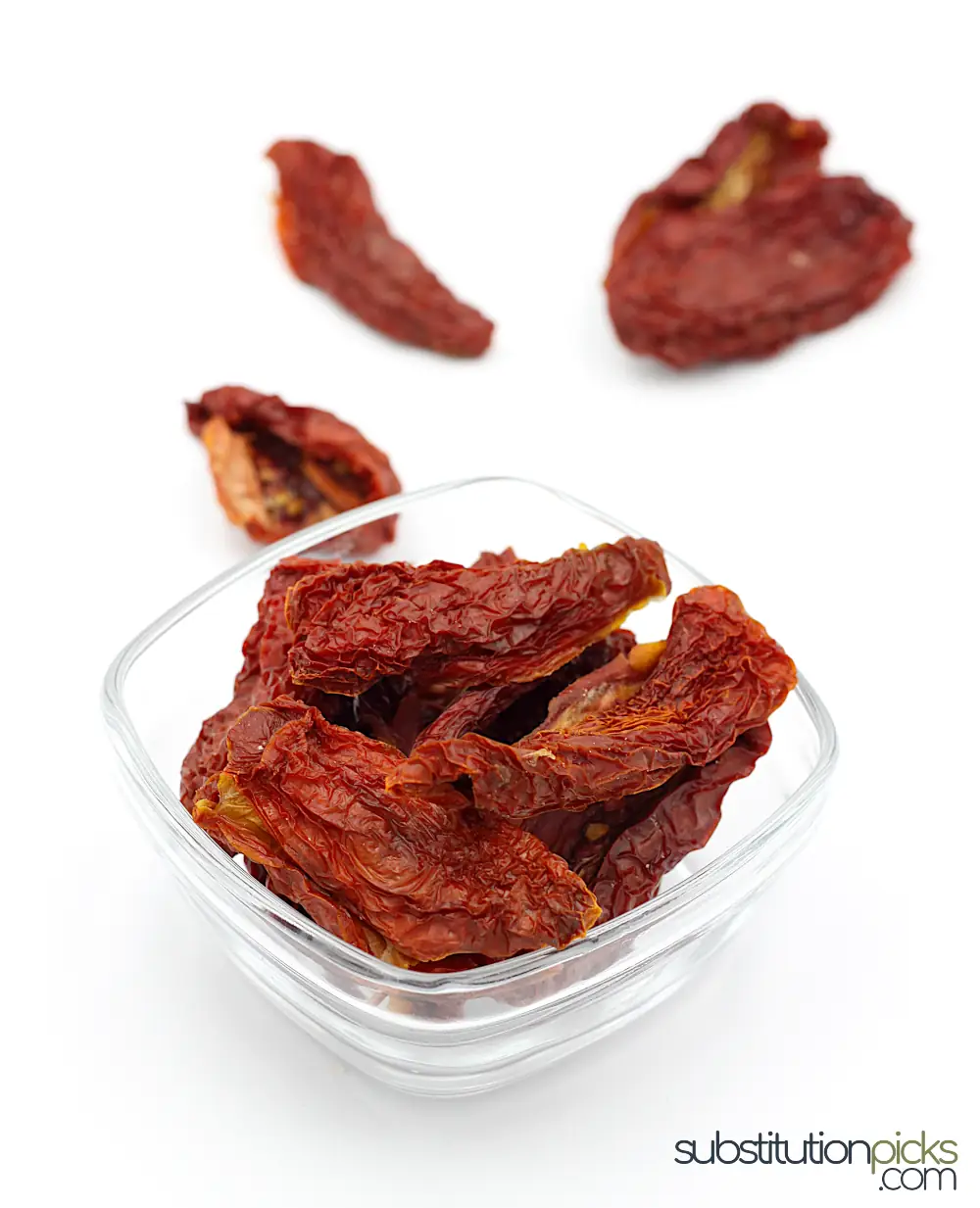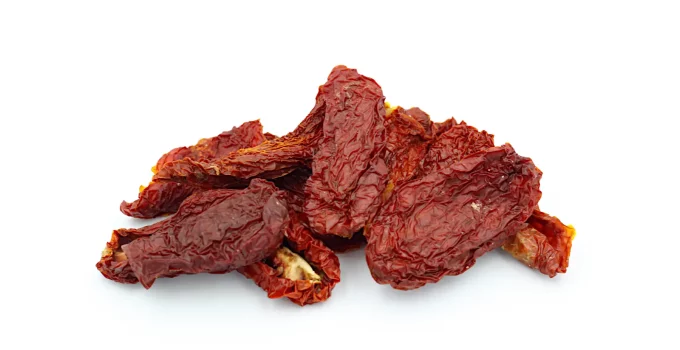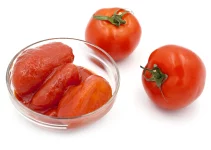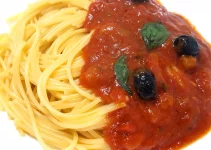There are quite a lot of options when it comes to sun-dried tomato substitutes. Fortunately, even if we don’t particularly like them or can’t find them, you have other replacements to consider.
The best sun-dried tomato substitutes are:
- fresh tomatoes, whatever variety you prefer cooking with
- canned tomatoes
- tomato puree
- or tomato paste
These are the 4 main replacements and we’re going to see how each of these would work for recipes.
Vice-versa, you can also use sun-dried instead of any of these 4 options when you want a more intense flavor, with a bit of a smoky hint.
If you’re looking for substitutes that have nothing to do with tomatoes, you could use: roasted bell peppers, mushrooms, and artichoke hearts.
Table of Contents
Sun-Dried Tomato Substitutes: How to Use them

Let’s break down each substitute and see which one is best suited for your recipe.
1. Fresh Tomatoes
Using fresh tomatoes is easy and it’s the way to go if they’re in season.
Moreover, if sun-dried tomatoes are used for making sandwiches, then you can’t use canned as a substitute in this situation.
Just use whatever fresh, delicious varieties you can get your hands on.
Fresh tomatoes are very easy to use in cold dishes because you can easily gauge proportions and can make the substitution according to your tastes.
Usually, for 1/2 cup sun-dried tomatoes, you should use 4-6 fresh plum tomatoes.
2. Canned Tomatoes as a Sun-dried Tomato Substitute
Canned tomatoes are awesome substitutes.
The thing you need to remember is that canned tomatoes contain a lot of liquid, while sun-dried ones don’t have any liquid since they’ve been dehydrated. That’s the adjustment you must take into account.
Even if you’re only using the tomatoes inside the can and none of the sauce, there’s still going to be a lot more water than it would if you were cooking with sun-dried.
Canned tomatoes are especially an awesome replacement when you’re using them for making sauces. Once again, you should know that your sauce will be thinner.
For 1/2 cup sun-dried tomatoes you should use 1 1/2 cups drained canned tomatoes.
3. Tomato Puree/Paste
Using either tomato puree or paste is an awesome idea if you’re making soups. Just add 2 tablespoons or even more, depending on your taste.
Since you can taste the soup as it’s cooking, you can add as much tomato puree or paste as you’d like.
I also enjoy making various soups with fresh peeled tomatoes. That’s another substitute you can use.
If the recipe calls for sun-dried tomato paste, use the same amount of tomato paste. The flavor should be just as intense for both pastes.
How to Cook with Sun-Dried Tomatoes
In order to understand how sun-dried tomato substitutes would work, we should understand what exactly this ingredient that we’re trying to replace is and how we cook with it.
What are sun-dried tomatoes?
The idea behind them is that people used to dry fruits and vegetables in the sun as a means of preserving food way back when there was no technology at all.
This preservation method ensures that they get a brilliant red color, more intense than the fresh tomatoes, and that the flavor of ripe tomatoes is preserved.
They can also have a bit of a smoky flavor. It’s definitely more intense.
Nowadays, you could also be using an electric food dehydrator if you wanted to make them at home. Or dry them in the oven.
Sun-dried are especially used in the Mediterranean region. If you’re shopping at an Italian market, there’s no way you won’t come across these in various forms. They’re still not incredibly popular across the globe and amateur cooks are still not using this ingredient frequently.
I just have to admit that I’m still not entirely used to them either. On the other hand, my father loves them.
Sun-dried tomatoes types
Usually, ripe plum tomatoes are dried in the sun. The most frequent dried varieties are: Roma, San Marzano, grape or cherry tomatoes. When it comes to dehydrating them, Roma are a favorite for many.
Dry-packed
After that, they can be placed in bags just like that. This is called dry-packed.
They’re also a pretty affordable option.
Packed in oil
Or they can be preserved in oil. Additional ingredients like herbs, paprika, garlic can also be added in the oil.
This type is also the most expensive, especially if you’re buying those preserved in olive oil.
Sunflower oil is cheaper.
The advantage of buying those packed in oil is that the oil and herbs can soften the flavor. In return, the oil also becomes something more delicious that can be used in salad dressings since it has a burst of flavor.
However, the main advantage is that these are ready to use straight from the jar.
Paste
They can also be available in the form of pastes or purees.
The paste is a good idea to have around the house if you just need 1 or 2 tablespoons in your recipes. It’s sold in tubes or jars.
Another type is granules, which can be sprinkled directly onto the prepared dishes like a seasoning.
How to cook with them
Sun-dried are a versatile ingredient.
You can use them to make sauces, pizza, pasta, soups, salads, sandwiches, various appetizers, etc.
They work well with garlic, herbs, olive oil, vegetables, seafood, and poultry.
How to rehydrated sun-dried tomatoes
If you’re getting the dry packed kind, that hasn’t been preserved in oil, your first step is to rehydrate them.
This type is chewier and has tougher skin. It would be best if you could get the oil-packed type but these are about 3 times more expensive than the dry-packed.
You can rehydrate them in warm water but it has the risk of diluting the flavor. To offset that risk, it’s best to use salt water – water mixed with salt. For one cup of water you should use 1/2 teaspoon of salt.
Wine is another liquid that can be used but it can overpower the acidity of the tomatoes.
Thus, I recommend using either vegetable or chicken broth, it depends on your diet and what you have in the kitchen.
This is how you rehydrate dry-packed sun-dried tomatoes:
- in a heatproof bowl, place 1/2 cup tomatoes
- cover with 1 cup broth or 1 cup water + 1/2 teaspoon of salt
- cover the bowl with a plate
- microwave for 2 minutes
- let them sit for 5 to 10 minutes, until the skin gets soft
- remove them from the water/broth and blot until dry with paper towels
If you want to take the shortcut, just refresh them in boiling water for 2-10 minutes.
If you cover them with oil, you can keep them in an airtight container in the fridge for about 2 weeks.
Therefore, you either pay plenty of money on the oil-packed kind or you get the dry-packed ones and rehydrate them.
Or you can get any of the above sun-dried tomato substitutes and use ingredients that you know exactly how to handle.
Drying Tomatoes at Home
There are 3 main ways for drying tomatoes at home: in the sun, in the oven or by using a food hydrator.
A food hydrator will come with its own instructions so let’s cover the other 2 methods.
In the sun
If you live in a hot, dry climate, you could try drying them in the sun. It would be especially lovely if you were to grow your own Roma tomatoes.
The conditions are simple: several consecutive days with temperatures above 85 degrees Fahrenheit.
Before drying: dip the tomatoes in boiling water then ice water. Dry, core, and halve them lengthwise.
You could sprinkle them with salt or not. That’s just a personal preference that has no impact on the process.
Arrange the half tomatoes on line racks or deep trays with double layers of cheesecloth.
Place them with the cut side up.
Leave room for air circulation.
Cover them with cheesecloth or nylon netting for protection against insects.
Let them dry above the ground in the sun.
If the trays don’t have air holes, turn them manually after the juice has evaporated from the cavity.
After that, turn them daily for 2-4 days. Or until all the moisture is gone.
Check for molding. You can bring them inside during cool nights and especially if it starts to rain.
Oven drying
Nowadays, there are countertop ovens that even include a dehydrate function. Check the manual if your oven comes with such a function and see what are the instructions.
Otherwise, preheat your oven at 175 degrees Fahrenheit or even lower if your oven allows temperatures between 130 and 150 degrees Fahrenheit.
Prepare the tomatoes as I described above and then place them cut side up onto drying trays.
Prop oven the oven door at least 4 inches.
Let them dry for 6-16 hours.
Reduce the heat toward the end.
Turn the trays frequently to prevent scorching
Remove the individual pieces as they’re done.
If you’re not in the mood for spending money on any kind of sun-dried tomatoes and you definitely don’t want to dry your own, then just use any of the above sun-dried tomato substitutes, according to what would be most suitable for what you’re cooking.




